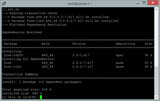Εγκαταστήστε το Plesk στο CentOS 7
Χρησιμοποιώντας ένα διαφορετικό σύστημα; Το Plesk είναι ένας ιδιόκτητος πίνακας ελέγχου web host που επιτρέπει στους χρήστες να διαχειρίζονται τους προσωπικούς ή/και τους πελάτες τους ιστότοπους, βάσεις δεδομένων
ERP or Enterprise Resource Planning is an enterprise application suite used to manage core business processes. ERPNext is free and open source self-hosted ERP application written in Python. It uses Node.js for the front end and MariaDB to store its data. ERPNext provides an easy-to-use web interface that allows businesses to manage the day to day tasks. It contains modules for accounting, CRM, HRM, manufacturing, POS, project management, purchasing, sales management, warehouse management, and more. ERPNext can be used to manage different industries such as service providers, manufacturing, retail and schools.
In this tutorial, we will install ERPNext on CentOS 7.
For this tutorial, we will use erp.example.com as the domain name pointed to the server. Please make sure to replace all occurrences of erp.example.com with your actual domain name.
Update your base system using the guide "How to Update CentOS 7". Once your system has been updated, proceed to install Python.
ERPNext needs Python version 2.7 to work. Python 2.7 is installed by default in all CentOS server instances. You can check if the installed version of Python by running:
python -V
You should get the similar output.
[user@vultr ~]$ python -V
Python 2.7.5
Though the installed version of Python is not the latest, it works without a hitch. Changing the default version of Python may break YUM.
Install the packages in the Development tools group that are required for compiling the installer files.
sudo yum groupinstall -y "Development tools"
Install a few more dependencies:
sudo yum install -y redhat-lsb-core git python-setuptools python-devel openssl-devel libffi-devel
Install Python's pip tool. Pip is the dependency manager for Python packages.
wget https://bootstrap.pypa.io/get-pip.py
sudo python get-pip.py
The above command will install Pip onto your system. To ensure that you have the latest version of pip and setuptools, run:
sudo pip install --upgrade pip setuptools
Install Ansible using Pip. Ansible automates software provisioning, configuration management, and application deployment.
sudo pip install ansible
MariaDB is a fork of MySQL database server. Install MariaDB by running.
sudo yum -y install mariadb mariadb-server mysql-devel
The Barracuda storage engine is required for the creation of ERPNext databases, hence you will need to configure MariaDB to use the Barracuda storage engine. Edit the default MariaDB configuration file my.cnf.
sudo nano /etc/my.cnf
Add the following lines under the symbolic-links=0 line.
innodb-file-format=barracuda
innodb-file-per-table=1
innodb-large-prefix=1
character-set-client-handshake = FALSE
character-set-server = utf8mb4
collation-server = utf8mb4_unicode_ci
[mysql]
default-character-set = utf8mb4
Start MariaDB and enable it to automatically start at boot time.
sudo systemctl start mariadb.service
sudo systemctl enable mariadb.service
Before configuring the database, you will need to secure MariaDB. You can secure it by running the mysql_secure_installation script:
sudo mysql_secure_installation
You will be asked for the current MariaDB root password. By default, there is no root password set on MariaDB. Press the "Enter" key to proceed. Set a strong password for the root user of your MariaDB server and answer "Y" to all of the other questions which are asked. The questions asked are self-explanatory.
As the EPEL repository is installed by default in all Vultr CentOS 7 instances, you can directly install Redis and Nginx. But to install the latest version of Node.js, you will need to add the Nodesource repository into your system.
Add the Nodesource repository for Node.js 8.x.
sudo curl --silent --location https://rpm.nodesource.com/setup_8.x | sudo bash -
Install Nginx, Nodejs and Redis:
sudo yum -y install nginx nodejs redis
Start Nginx and enable it to start at boot time by running:
sudo systemctl start nginx
sudo systemctl enable nginx
Start Redis and enable it to start at boot time by running:
sudo systemctl start redis
sudo systemctl enable redis
The wkhtmltopdf program is a command line tool that converts HTML into PDF using the QT Webkit rendering engine. Install the required dependencies:
sudo yum -y install libXrender libXext xorg-x11-fonts-75dpi xorg-x11-fonts-Type1
Download the latest version of wkhtmltopdf.
wget https://github.com/wkhtmltopdf/wkhtmltopdf/releases/download/0.12.4/wkhtmltox-0.12.4_linux-generic-amd64.tar.xz
Extract the archive by running:
sudo tar -xf wkhtmltox-0.12.4_linux-generic-amd64.tar.xz -C /opt
The above command will extract the archive to /opt/wkhtmltox. Create a softlink so that wkhtmltopdf and wkhtmltoimage can be executed globally as a command.
sudo ln -s /opt/wkhtmltox/bin/wkhtmltopdf /usr/bin/wkhtmltopdf
sudo ln -s /opt/wkhtmltox/bin/wkhtmltoimage /usr/bin/wkhtmltoimage
You can now run wkhtmltopdf -V command to check if it is working, you will see:
[user@vultr ~]$ wkhtmltopdf -V
wkhtmltopdf 0.12.4 (with patched qt)
At this point, we have all the required dependencies installed. You can now proceed to install Bench.
Bench is a command line utility provided by Frappe to install and manage the ERPNext application on a Unix-based system for both development and production purposes. Bench can also create and manage Nginx and supervisor configuration.
Create a new user to run Bench processes in the isolated environment.
sudo adduser bench -d /opt/bench
Change the password of the user.
sudo passwd bench
Provide sudo permissions to the bench user.
sudo usermod -aG wheel bench
Login as the newly created bench user:
sudo su - bench
Clone the Bench repository in /opt/bench:
cd /opt/bench
git clone https://github.com/frappe/bench bench-repo
Install Bench using pip.
sudo pip install -e bench-repo
Once Bench is installed, proceed further to install ERPNext using Bench.
Initialize a bench directory with frappe framework installed. To keep everything tidy, we will work under /opt/bench directory. Bench will also setup regular backups and auto updates once a day.
cd /opt/bench
bench init erpnext && cd erpnext
Create a new Frappe site:
bench new-site erp.example.com
The above command will prompt you for the MySQL root password. Provide the password which you have set for the MySQL root user earlier. It will also ask you to set a new password for the administrator account. You will need this password later to log into the administrator dashboard.
Download ERPNext installation files from the remote git repository using the Bench.
bench get-app erpnext https://github.com/frappe/erpnext
Install ERPNext on your newly created site:
bench --site erp.example.com install-app erpnext
ERPNext is installed on your server. You can start the application immediately to check if the application is started successfully:
bench start
However, you should stop the execution and proceed further to set up the application for production use.
By default, the ERPNext application listens on port 8000, not to the standard HTTP port 80. Also, running the built in web server for production use is not recommended as we will be exposing the server to the world. Hence, you should use a production web server as reverse proxy such as Apache or Nginx. In this tutorial, we will use Nginx as a reverse proxy as it can be automatically configured using Bench. Bench can automatically generate and install the configuration according to the ERPNext setup.
Although we can start the application using the above command, the execution of ERPNext will stop as soon as you close the terminal. To overcome this issue, I recommend to use Supervisor which is very helpful in running the application continuously in a production environment. Supervisor is a process control system that enables you to monitor and control a number of processes on Linux operating systems. Once Supervisor is configured, it will automatically start the application at boot time as well as on failures. Bench can automatically configure Supervisor for the ERPNext application.
Install Supervisor:
sudo yum -y install supervisor
Start Supervisor and enable it to automatically start at boot time:
sudo systemctl start supervisord
sudo systemctl enable supervisord
Setup Bench for production use:
sudo bench setup production bench
The above command may prompt you before replacing the existing Supervisor default configuration file with a new one. Choose y to proceed. Bench adds a number of processes to Supervisor configuration file. The above command will also ask you if you wish to replace the current Nginx configuration with a new one. Enter y to proceed. Once Bench has finished installing the configuration, provide other users to execute the files in your home directory of Bench user.
chmod o+x /opt/bench/
If you are running a firewall on your server, you will need to configure the firewall to set an exception for HTTP service. Allow Nginx reverse proxy to connect from outside the network.
sudo firewall-cmd --zone=public --permanent --add-service=http
sudo firewall-cmd --reload
You can now access the site on http://erp.example.com.
You can check the status of the processes by running:
sudo supervisorctl status all
You should see the following output:
[bench@vultr ~]$ sudo supervisorctl status all
erpnext-redis:erpnext-redis-cache RUNNING pid 2554, uptime 1:06:58
erpnext-redis:erpnext-redis-queue RUNNING pid 2553, uptime 1:06:58
erpnext-redis:erpnext-redis-socketio RUNNING pid 2555, uptime 1:06:58
erpnext-web:erpnext-frappe-web RUNNING pid 2559, uptime 1:06:58
erpnext-web:erpnext-node-socketio RUNNING pid 2556, uptime 1:06:58
erpnext-workers:erpnext-frappe-default-worker-0 RUNNING pid 2549, uptime 1:06:58
erpnext-workers:erpnext-frappe-long-worker-0 RUNNING pid 2551, uptime 1:06:58
erpnext-workers:erpnext-frappe-schedule RUNNING pid 2550, uptime 1:06:58
erpnext-workers:erpnext-frappe-short-worker-0 RUNNING pid 2552, uptime 1:06:58
To stop all of the ERPNext processes, use:
sudo supervisorctl stop all
To start all the ERPNext processes, use:
sudo supervisorctl start all
Let's Encrypt provides free SSL certificates to the users. SSL can be installed manually or automatically through Bench. Bench can automatically install the Let's Encrypt client and obtain the certificates. Additionally, it automatically updates the Nginx configuration to use the certificates.
The domain name which you are using to obtain the certificates from the Let's Encrypt CA must be pointed towards the server. The client verifies the domain authority before issuing the certificates.
Enable DNS multi-tenancy for the ERPNext application.
bench config dns_multitenant on
Run Bench to set up Let's Encrypt on your site:
sudo bench setup lets-encrypt erp.example.com
During the execution of the script, the Let's Encrypt client will ask you to temporarily stop the Nginx web server. It will automatically install the required packages and Let's Encrypt client. The client will prompt for your email address. You will also need to accept the terms and conditions. Once the certificates have been generated, Bench will also generate the new configuration for Nginx which uses the SSL certificates. You will be asked before replacing the existing configuration. Bench also creates a crontab entry to automatically renew the certificates every month.
Finally, enable scheduler to automatically run the scheduled jobs:
bench enable-scheduler
You should see:
[bench@vultr erpnext]$ bench enable-scheduler
Enabled for erp.example.com
Once the process has finished, you can access your application at https://erp.example.com. Login with the username Administrator and the password you have set during installation. You will be taken to the desk where you will need to provide information to set ERPNext ERP according to your company. You can now use the application to manage your company.
Congratulations, you have a fully working ERPNext application installed on your CentOS 7 server.
Χρησιμοποιώντας ένα διαφορετικό σύστημα; Το Plesk είναι ένας ιδιόκτητος πίνακας ελέγχου web host που επιτρέπει στους χρήστες να διαχειρίζονται τους προσωπικούς ή/και τους πελάτες τους ιστότοπους, βάσεις δεδομένων
Το Squid είναι ένα δημοφιλές, δωρεάν πρόγραμμα Linux που σας επιτρέπει να δημιουργήσετε έναν διακομιστή μεσολάβησης web προώθησης. Σε αυτόν τον οδηγό, θα δείτε πώς να εγκαταστήσετε το Squid στο CentOS για να σας μετατρέψει
Εισαγωγή Το Lighttpd είναι ένα πιρούνι του Apache που έχει ως στόχο να είναι πολύ λιγότερο εντάσεως πόρων. Είναι ελαφρύ, εξ ου και το όνομά του, και είναι αρκετά απλό στη χρήση. Εγκατάσταση
Το Icinga2 είναι ένα ισχυρό σύστημα παρακολούθησης και όταν χρησιμοποιείται σε μοντέλο master-client, μπορεί να αντικαταστήσει την ανάγκη για ελέγχους παρακολούθησης που βασίζονται σε NRPE. Ο κύριος-πελάτης
Χρησιμοποιώντας ένα διαφορετικό σύστημα; Το Apache Cassandra είναι ένα δωρεάν και ανοιχτού κώδικα σύστημα διαχείρισης βάσεων δεδομένων NoSQL που έχει σχεδιαστεί για να παρέχει επεκτασιμότητα, υψηλή
Χρησιμοποιώντας ένα διαφορετικό σύστημα; Το Microweber είναι ένα ανοικτού κώδικα μεταφοράς και απόθεσης CMS και ηλεκτρονικό κατάστημα. Ο πηγαίος κώδικας Microweber φιλοξενείται στο GitHub. Αυτός ο οδηγός θα σας δείξει
Χρησιμοποιώντας ένα διαφορετικό σύστημα; Το Vanilla forum είναι μια εφαρμογή φόρουμ ανοιχτού κώδικα γραμμένη σε PHP. Είναι πλήρως προσαρμόσιμο, εύκολο στη χρήση και υποστηρίζει εξωτερικά
Χρησιμοποιώντας ένα διαφορετικό σύστημα; Το Mattermost είναι μια εναλλακτική λύση ανοιχτού κώδικα, που φιλοξενείται από τον εαυτό της στην υπηρεσία ανταλλαγής μηνυμάτων Slack SAAS. Με άλλα λόγια, με το Mattermost, μπορείτε περίπου
Ο πίνακας ελέγχου Plesk διαθέτει μια πολύ ωραία ενσωμάτωση για το Lets Encrypt. Το Lets Encrypt είναι ένας από τους μόνους παρόχους SSL που εκδίδει πιστοποιητικά πλήρως
Το Lets Encrypt είναι μια αρχή έκδοσης πιστοποιητικών αφιερωμένη στην παροχή πιστοποιητικών SSL δωρεάν. Το cPanel έχει δημιουργήσει μια τακτοποιημένη ενοποίηση για εσάς και τον πελάτη σας
Χρησιμοποιώντας ένα διαφορετικό σύστημα; Το Concrete5 είναι ένα CMS ανοιχτού κώδικα που προσφέρει πολλές χαρακτηριστικές και χρήσιμες λειτουργίες για να βοηθήσει τους συντάκτες να παράγουν περιεχόμενο εύκολα και
Χρησιμοποιώντας ένα διαφορετικό σύστημα; Το Review Board είναι ένα δωρεάν και ανοιχτού κώδικα εργαλείο για την ανασκόπηση του πηγαίου κώδικα, της τεκμηρίωσης, των εικόνων και πολλών άλλων. Είναι λογισμικό που βασίζεται στο web
Σε αυτόν τον οδηγό, θα μάθετε πώς να ρυθμίζετε τον έλεγχο ταυτότητας HTTP για έναν διακομιστή web Nginx που εκτελείται σε CentOS 7. Απαιτήσεις Για να ξεκινήσετε, θα χρειαστείτε
Το YOURLS (Your Own URL Shortener) είναι μια εφαρμογή συντόμευσης διευθύνσεων URL και ανάλυσης δεδομένων ανοιχτού κώδικα. Σε αυτό το άρθρο, θα καλύψουμε τη διαδικασία εγκατάστασης
Χρησιμοποιώντας ένα διαφορετικό σύστημα; Εισαγωγή Το ArangoDB είναι μια βάση δεδομένων NoSQL ανοιχτού κώδικα με ένα ευέλικτο μοντέλο δεδομένων για έγγραφα, γραφήματα και κλειδιά-τιμές. είναι
Εισαγωγή Ο κατάλογος /etc/ παίζει κρίσιμο ρόλο στον τρόπο λειτουργίας ενός συστήματος Linux. Ο λόγος για αυτό είναι επειδή σχεδόν κάθε διαμόρφωση συστήματος
Πολλοί διαχειριστές συστημάτων διαχειρίζονται μεγάλες ποσότητες διακομιστών. Όταν χρειάζεται πρόσβαση στα αρχεία σε διαφορετικούς διακομιστές, συνδέεστε σε καθένα ξεχωριστά περίπου
Αυτό το σεμινάριο θα καλύψει τη διαδικασία εγκατάστασης ενός διακομιστή παιχνιδιών Half Life 2 στο σύστημα CentOS 6. Βήμα 1: Εγκατάσταση των προαπαιτούμενων Για να ρυθμίσετε το ou
Το Laravel GitScrum ή GitScrum είναι ένα εργαλείο παραγωγικότητας ανοιχτού κώδικα που έχει σχεδιαστεί για να βοηθά τις ομάδες ανάπτυξης να εφαρμόσουν τη μεθοδολογία Scrum με παρόμοιο τρόπο
Εισαγωγή Σε αυτό το σεμινάριο Vultr, θα μάθετε πώς να εγκαταστήσετε το PowerDNS. Το PowerDNS είναι ένα πρόγραμμα για την εκτέλεση των δικών σας διακομιστών ονομάτων. Είναι πολύ χρήσιμο όταν
Η Τεχνητή Νοημοσύνη δεν είναι στο μέλλον, είναι εδώ ακριβώς στο παρόν Σε αυτό το blog Διαβάστε πώς οι εφαρμογές Τεχνητής Νοημοσύνης έχουν επηρεάσει διάφορους τομείς.
Είστε επίσης θύμα των επιθέσεων DDOS και έχετε μπερδευτεί σχετικά με τις μεθόδους πρόληψης; Διαβάστε αυτό το άρθρο για να λύσετε τις απορίες σας.
Μπορεί να έχετε ακούσει ότι οι χάκερ κερδίζουν πολλά χρήματα, αλλά έχετε αναρωτηθεί ποτέ πώς κερδίζουν τέτοια χρήματα; ας συζητήσουμε.
Θέλετε να δείτε επαναστατικές εφευρέσεις της Google και πώς αυτές οι εφευρέσεις άλλαξαν τη ζωή κάθε ανθρώπου σήμερα; Στη συνέχεια, διαβάστε στο blog για να δείτε τις εφευρέσεις της Google.
Η ιδέα των αυτοκινούμενων αυτοκινήτων να βγαίνουν στους δρόμους με τη βοήθεια της τεχνητής νοημοσύνης είναι ένα όνειρο που έχουμε εδώ και καιρό. Όμως, παρά τις πολλές υποσχέσεις, δεν φαίνονται πουθενά. Διαβάστε αυτό το blog για να μάθετε περισσότερα…
Καθώς η Επιστήμη εξελίσσεται με γρήγορους ρυθμούς, αναλαμβάνοντας πολλές από τις προσπάθειές μας, αυξάνονται και οι κίνδυνοι να υποβάλλουμε τον εαυτό μας σε μια ανεξήγητη Ιδιότητα. Διαβάστε τι σημαίνει η μοναδικότητα για εμάς.
Οι μέθοδοι αποθήκευσης των δεδομένων εξελίσσονται μπορεί να είναι από τη γέννηση των Δεδομένων. Αυτό το ιστολόγιο καλύπτει την εξέλιξη της αποθήκευσης δεδομένων με βάση ένα infographic.
Διαβάστε το ιστολόγιο για να μάθετε διαφορετικά επίπεδα στην Αρχιτεκτονική Μεγάλων Δεδομένων και τις λειτουργίες τους με τον απλούστερο τρόπο.
Σε αυτόν τον ψηφιακό κόσμο, οι έξυπνες οικιακές συσκευές έχουν γίνει κρίσιμο μέρος της ζωής. Ακολουθούν μερικά εκπληκτικά οφέλη των έξυπνων οικιακών συσκευών σχετικά με το πώς κάνουν τη ζωή μας να αξίζει και να απλοποιείται.
Πρόσφατα, η Apple κυκλοφόρησε το macOS Catalina 10.15.4 μια συμπληρωματική ενημέρωση για την επιδιόρθωση προβλημάτων, αλλά φαίνεται ότι η ενημέρωση προκαλεί περισσότερα προβλήματα που οδηγούν σε bricking των μηχανών mac. Διαβάστε αυτό το άρθρο για να μάθετε περισσότερα








